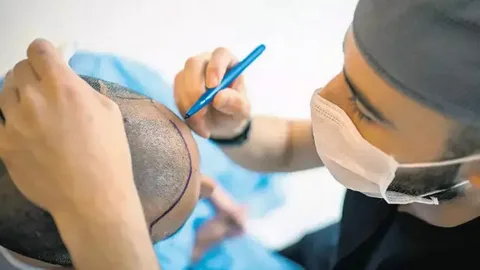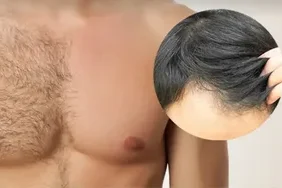If you’re struggling with limited scalp donor hair and wondering if hair Can Hair Be Transplanted from Body to Head? The answer is yes, through a procedure called Body Hair Transplant (BHT).
This advanced technique offers hope for patients with severe baldness or poor donor density. In this article, you’ll learn how BHT works, what areas of the body it is used on, its success rate, and whether it’s the right option for you.
Get clear answers from a medically accurate, expert-backed guide.
What Is a Body Hair Transplant (BHT)?
Body Hair Transplant (BHT) is a type of hair restoration procedure where follicles are extracted from areas such as the chest, beard, arms, or legs and transplanted to the scalp.
It uses the same basic principle as Follicular Unit Extraction (FUE), but with non-scalp donor sources.
Key points:
- Ideal for patients with poor scalp donor supply
- Commonly used in advanced stages of baldness (Norwood 5–7)
- Often combined with scalp donor hair for density optimization
When Is BHT Used? Indications & Patient Scenarios
Who is BHT ideal for?
- Individuals with depleted scalp donor areas
- Patients requiring repair after failed transplants
- People with scarring alopecia or scalp trauma
- Candidates for mega sessions (>4000 grafts)
Pro Tip: BHT is best suited for patients with coarse beard or chest hair, as they more closely match scalp hair in growth potential and texture.

Donor Areas for Body-to-Head Hair Transplants
1. Beard Hair
- Most commonly used body donor site
- Thick, robust follicles with a strong growth rate
- Best for mid-scalp and crown zones
2. Chest Hair
- Suitable for blending in crown areas
- Slightly shorter anagen (growth) phase than scalp hair
3. Arms, Legs, Abdomen, Back
- Less preferred due to finer texture and slower growth
- Used only in cases of extreme donor shortage
Important: Hair cycle mismatch and curl variation between body and scalp hairs can affect aesthetic outcomes, which is why surgeon expertise is crucial.
Procedure: How Is Body Hair Transplant Performed?
- Consultation & Assessment: Determine donor viability using trichoscopy and density mapping
- FUE Extraction: Hair follicles are harvested one by one using micro punches (0.7–0.9 mm)
- Storage & Handling: Grafts are preserved in special holding solutions for vitality
- Implantation: Follicles are implanted in the scalp using precision tools to match direction and angle

Is Body Hair Transplant Effective? Success Rates & Growth Expectations
Growth Rate Insights:
- Beard grafts: ~75–90% survival rate
- Chest hair: ~60–80% survival
- Limb hair: Less predictable (~40–60%)
Expert Insight:
According to Dr. Rana Irfan (ABHRS, ISHRS), “Beard and chest hair are increasingly reliable donor sources, especially when scalp supply is inadequate. However, patient selection and graft handling make all the difference in outcomes.”
Advantages and Limitations of Body Hair Transplant
✅ Pros:
- Expands donor supply
- Useful for repair cases
- Can achieve natural density when combined with scalp hair
❌ Cons:
- Requires surgical precision and high expertise
- Different textures may affect blending
- Longer sessions and healing time
Recovery & Aftercare: What to Expect After a BHT
- Healing: Body donor sites heal within 7–10 days
- Redness & Itching: Normal and resolves in 2 weeks
- Hair Shedding: A Temporary “shock loss” phase is expected
- Visible Growth: Starts after 3–4 months, full result in 12–15 months
Tips for Smoother Recovery:
- Avoid sweating, workouts, and sun exposure for 10–14 days
- Sleep elevated for the first few nights
- Use prescribed topical antibiotics on donor areas
Can Hair Be Transplanted from Any Body Part to the Head?
Technically, yes — but not all body hair behaves like scalp hair. Here’s a quick comparison:
| Body Area | Texture Match | Growth Cycle | Recommended Use |
|---|---|---|---|
| Beard | Excellent | Long | High-density zones |
| Chest | Moderate | Medium | Crown blending |
| Legs/Arms | Poor | Short | Last resort |

Common Myths About Body Hair Transplants
Myth 1: All body hair grows like scalp hair.
Reality: Body hair has different cycles; matching matters.
Myth 2: BHT looks unnatural.
Reality: With proper planning and angle adjustment, BHT results can look very natural.
Myth 3: It’s riskier than regular transplants.
Reality: With an experienced surgeon, the risks are similar to standard FUE.
FAQs
Q1: Is body hair transplant permanent?
Yes, body hair is DHT-resistant and retains its growth pattern even after being moved to the scalp.
Q2: How much does a BHT cost in Pakistan?
Body Hair Transplant typically ranges from PKR 100 to 200 per graft, depending on the clinic and surgeon’s expertise.
Q3: Can body hair be the only source for a full transplant?
It depends on the density needed. In advanced cases (Norwood 6–7), BHT is often combined with scalp hair for best results.
Q4: Is BHT more painful than scalp FUE?
Pain levels are similar, though chest and beard areas may feel slightly more tender post-op.
Book a Consultation with Dr. Rana Irfan
If you’re considering a body-to-head hair transplant, trust a certified expert to guide your journey. Dr. Rana Irfan (ABHRS, ISHRS) specializes in advanced FUE and BHT techniques in Islamabad with years of experience handling complex cases.
✅ Ready to restore your hair with confidence?
👉 Book a Consultation with Dr. Rana Irfan in Islamabad today!
